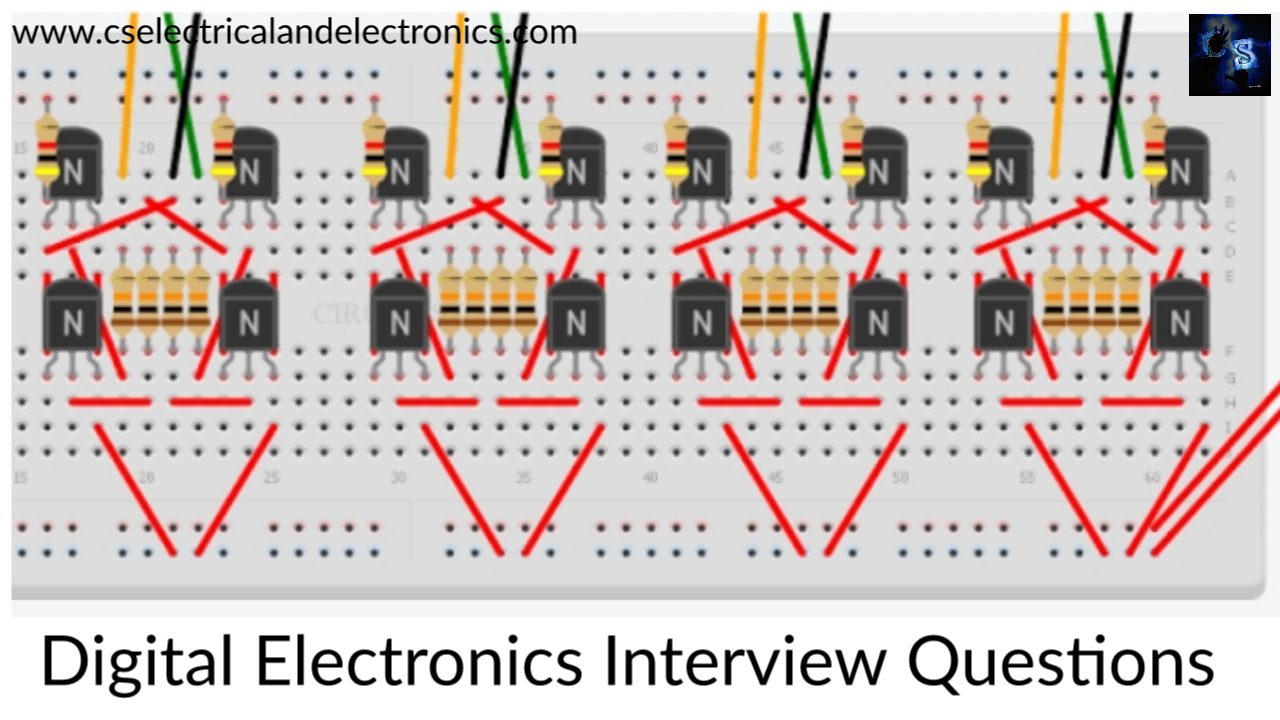Digital Electronics Interview Questions And Answer Most Commonly Asked
Hello guys, welcome back to my blog. In this article, I will discuss digital electronics interview questions and answer most commonly asked in technical rounds, technical round interview questions on digital electronics, etc.
If you have any doubts related to electrical, electronics, and computer science, then ask question. You can also catch me @ Instagram – Chetan Shidling.
Also, read:
- Power System Interview Questions And Answer Most Commonly Asked.
- Top 20 Electric Traction Interview Questions And Answers.
- Data Structures And Algorithms Top Interview Questions And Answers.
Digital Electronics Interview Questions
01. What are the types of number systems?
A. There are many types of number systems according to the base or radix of the number system but we usually consider the main number system are:
- Decimal number system (base 10)
- Binary number system (base 2)
- Octal number system (base 8)
- Hexa Decimal number system (base 16)
02. What is the difference between weighted and unweighted codes ?
A. Weighted codes:- the digits in the number system which depends on weight i.e.., which depends on base value Or radix value is known as weighted codes. Ex:-decimal,binary,octal,hexadecimal,BCD(8421),2421 etc.
Un weighted codes:-the digits will not depend on the weight i.e.., on the base or radix value is known as unweighted codes. Ex:- XS-3 code,error codes,gray code.
03. What is the difference between basic gates and universal gates?
A. Basic gates:-the basic gates are used for the multiplication, addition, inverse operation. Ex:-AND, OR, NOT.
Universal gates:-the universal gates are also the same as the AND and OR gates but the only difference is by these gates we can implement all other gates. Ex:-NAND, NOR.
04. What are the two forms of Boolean expressions?
A. The two forms of Boolean expressions are:
• The product of sum form
• Sum of products form
05. What is mean by Maxterm and Minterm?
A.
• A Minterm is known as the Product of sum
• A Maxterm is known as the sum of product
06. What is the difference between flip- flops and latches?
A. The difference between flip-flops and latches are:
Flipflop:-The device which stores a single bit of data is known as a flip flop.
Latch:-a latch is a special type of logic circuit and operates with signal level rather than signal transition.
07. What is a multiplexer?
A. Multiplexer is a mux that is used for the analog or digital inputs to a forwarded selected input to a single output. By using multiplexer we can implement any of the logic gates and circuits so, mux is a universal circuit.
08. What is demultiplexer?
A. A demultiplexer is a demux that has a single input and multi number of outputs. The demultiplexer is the reverse of a multiplexer.
09. What are the applications of demultiplexer?
A. The applications of demultiplexer are:
• It is used as a serial to parallel converters.
• It is used in data transmission systems with error detection.
• It is used for a single source to multi destinations.
10. What are the features of the combinational circuits?
A. The features of the combinational circuits are:
• No feedback.
• Output does not depend on the past input state.
• There is no memory.
11. What are the features of the sequential circuits?
A. The features of the sequential circuits are:
• Feedback is present.
• It depends on the past state of the input.
• Memory is present.
12. Name some universal gates and logic gates?
A. NAND gate and NOR gates are called as universal gates and AND,OR,NOT are basic logic gates.
13. What is Karnaugh map?
A. It is a method to simplify the Boolean algebra expressions and it is used to decrease or reduce the number of inputs to a circuit.
14. What is adder and subtractor?
A. Adder and subtractor means,
Adder:- adder is that which can perform the addition between two or more bits.
Subtractor:- subtractor is that which can perform the subtraction between two or more bits.
15. What is decoder?
A. Decoder means
• Circuitwise decoder and demultiplexer both are the same.
• It can convert less number of inputs to more number of outputs.
16. What is encoder?
A. Encoder converts more number of inputs to less number of outputs.
17. What is race around condition in flip-flop?
A. The flipflop won’t change it’s state it always be in the same state.
18. What is the purpose to go for SR flip-flop to JK flip-flop?
A. To overcome invalid state in SR flip-flop we will go for JK flip-flop.
19. What are essential prime implicants?
A. After simplifying the Boolean expression it may contain many expressions, the number of the common prime implicants of a Boolean expression is known as essential prime implicants.
20. What is duality theorem?
A. It states that we can get another Boolean expression with the existing Boolean expression by:
• Complimenting 1 and 0 in the expression by changing 1 to 0 and 0 to 1
• Changing the AND operation (. Dot Sign) to OR process (+ Sign) and vice versa.
I hope this article “Digital Electronics Interview Questions And Answer” may help you all a lot. Thank you for reading.
Also, read:
- 100 + Electrical Engineering Projects For Students, Engineers
- 1000+ Automotive Interview Questions With Answers
- 1000+ Electronics Projects For Engineers, Diploma, MTech Students
- 1000+ MATLAB Simulink Projects For MTech, Engineering Students
- 50 Advanced Level Interview Questions On CAPL Scripting
- 500+ Embedded System Projects For Engineer, Diploma, MTech, PhD
- 500+ Projects For Diploma Electrical, Electronics Student, Diploma Project
- 8051 Microcontroller Timers, TCON Register, TMOD Register
